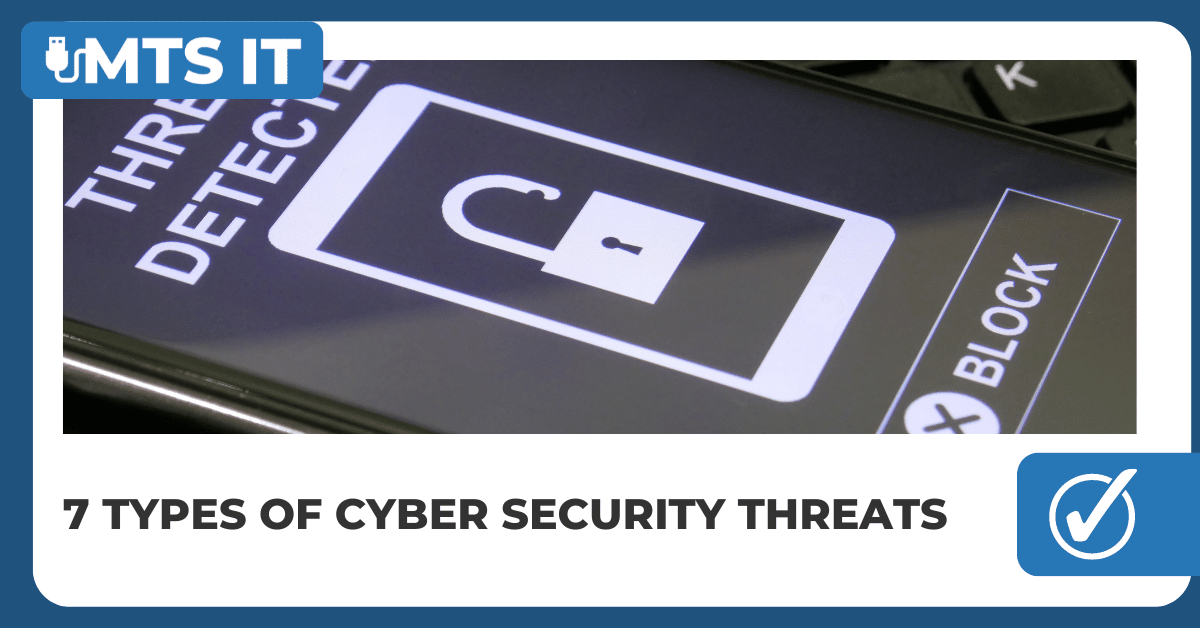A cyber security threat is a malicious act that seeks to damage data, steal data, or disrupt digital life in general. Cyber threats can originate from various actors, including corporate spies, hacktivists, terrorist groups, hostile nation-states, criminal organizations, lone hackers and disgruntled employees. But, what can hackers do with your data?
- Hackers can sell your data to other criminals
- Stolen personal information is fuel for identity theft
- Login details are needed for account takeover
- Stolen data is used to target phishing attacks and extortion
- Stolen personal information can be used to harm companies
Cyber security threats can be very dangerous and damaging to an individual or an organisation which is why cyber security professionals are essential for keeping private data protected.
7 Types of Cyber Security Threats
Cyber security professionals should have an in-depth understanding of the following types of cyber security threats.
Malware
Malware is malicious software such as spyware, ransomware, viruses and worms. Malware is activated when a user clicks on a malicious link or attachment, which leads to installing dangerous software. Malware, once activated, can:
- Block access to key network components (ransomware)
- Install additional harmful software
- Covertly obtain information by transmitting data from the hard drive (spyware)
- Disrupt individual parts, making the system inoperable
Emotet
Emotet is identified by the Cyber Security and Infrastructure Security Agency (CISA) as “a powerful, modular banking Trojan that mainly serves as a downloader or drop of other banking Trojans.” Emotet remains among the most costly and damaging viruses”.
Denial of Service
A denial of service (DoS) assault is a sort of cyber-attack that overloads a computer or network, making it unable to respond to requests. A dispersed denial of service (DDoS) attack does the same way, except the attack starts on a network connection. A flood attack is frequently used by cyber attackers to disrupt the “connection” process and pull out such a DoS. Several methods may be utilised, and some cyber attackers may leverage the downtime of a network to launch further assaults. A network is a type of DDoS in which millions of devices may be infected with malware, according to Jeff Melnick of Netwrix, an information technology security software company. and controlled by a hacker. Botnets, also known as zombie systems, attack and overwhelm a target’s processing capacity.
Man in the Middle
A man-in-the-middle (MITM) attack occurs when hackers insert themselves into a two-party transaction. After interrupting the traffic, they can filter and steal data. MITM attacks often occur when a visitor uses an unsecured public Wi-Fi network. Attackers insert themselves between the visitor and the network and then use malware to install software and use data maliciously.
Phishing
Phishing attacks use fake communication, such as an email, to trick the receiver into opening it and carrying out the instructions inside, such as providing a credit card number. The goal is to steal sensitive data like credit card and login information or to install malware on the victim’s machine.
SQL Injection
A Structured Query Language (SQL) injection is a type of cyber attack that results from inserting malicious code into a server that uses SQL. When infected, the server releases information. Submitting the malicious code can be as simple as entering it into a vulnerable website search box.
Password Attacks
With the right password, a cyber attacker has access to a wealth of information. Social engineering is a type of password attack that is defined as a strategy cyber attackers use that relies heavily on human interaction and often involves tricking people into breaking standard security practices. Other types of password attacks include accessing a password database or outright guessing.
How to protect your company from cyber-attack
- Train your employee(s)
- Maintain your Software & Systems up-to-date
- Ensure Endpoint Security
- Set up a Firewall
- Your data should be backed up
- You should be able to regulate who really has access to systems
- Administration of Access
When it comes to protecting your organisation against cybercrime and cyber-attacks, it can be tough to know where to start. There’s so much information out there that it’s easy to get overwhelmed, especially if it’s conflicting.
You require a solution that is suitable both for your business and your staff. Get in touch with us immediately for a cyber security assessment. We can assist you in getting going on your path to security.



